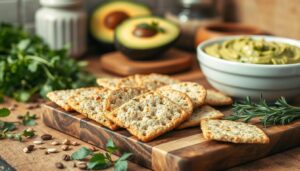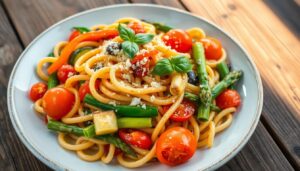Ever thought making creamy, dairy-free mayo at home could be simple? You’ll be amazed to find out making vegan mayo is easy and ready in just five minutes! This quick recipe is a tasty alternative to traditional mayo, great for adding a rich texture to your meals without eggs or dairy. With a 5-star rating from many users, it’s becoming a favorite condiment for many.

Now, let’s look at the ingredients and learn how to make this fantastic homemade vegan mayo. It stays fresh in the fridge for two weeks, making it a healthy choice for your sandwiches, salads, and more!
Table of Contents
Key Takeaways
- The easy vegan mayonnaise can be prepared in just 5 minutes.
- It has a 5-star rating from 20 user reviews, indicating high satisfaction.
- This homemade vegan mayo lasts in the fridge for up to 2 weeks.
- Key ingredients include soy milk, vinegar, and your choice of neutral oil.
- Using an immersion blender yields the best results for emulsification.
- Nutritional data shows 82 calories and 0mg cholesterol per tablespoon.
- Variations include substituting soy milk with aquafaba for different dietary needs.
Introduction to Vegan Mayonnaise
Vegan mayonnaise has become very popular lately. It’s a tasty, plant-based mayo that’s great for those who don’t eat dairy. Unlike regular mayonnaise, it’s made without eggs or dairy, but still has a creamy texture and rich taste.
Making your own vegan mayo is easy and quick, taking just five minutes. It’s perfect for adding to salads, sandwiches, or as a dip. This creamy condiment adds a special touch to many dishes.
By using ingredients like silken tofu or soy milk, along with Kala Namak, you get a taste that’s close to traditional mayo. You can also add your favorite flavors and spices to make it even better. This makes vegan mayo a must-have in any vegan kitchen.
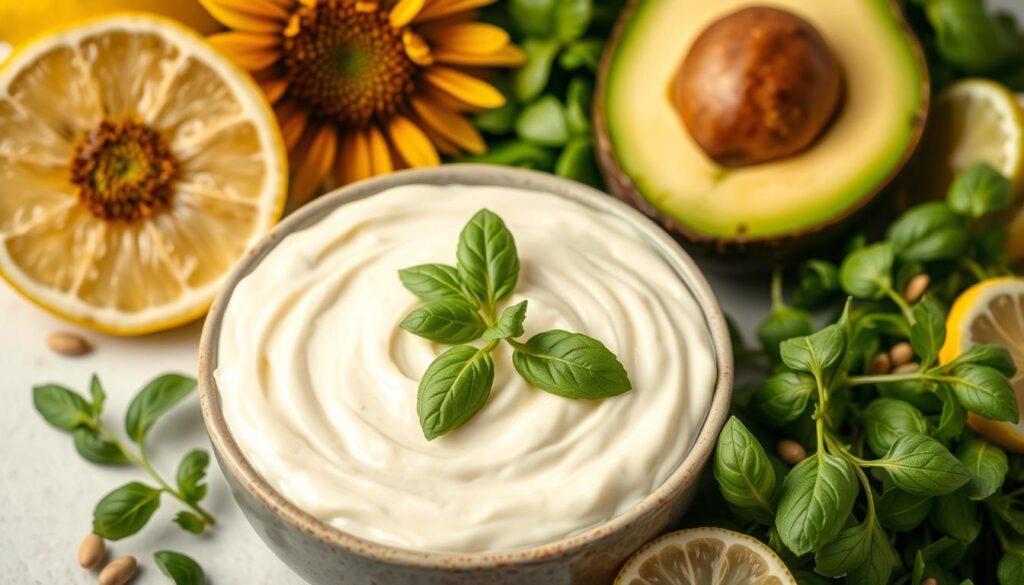
Why Make Homemade Vegan Mayo?
Making your own vegan mayonnaise has many benefits. It tastes fresher and lets you adjust the flavor to your liking. You choose the ingredients, making it healthier and perfect for vegan recipes.
It’s also cheaper to make your own mayo. This can save you money, especially if you use it a lot. Homemade mayo lasts about 1-2 weeks in the fridge, making it a great choice for everyday use.
Creating vegan mayo is quick, taking less than five minutes with an immersion blender. You just need soy milk, sunflower oil, and vinegar. It’s creamy and healthier than store-bought mayo, without preservatives.
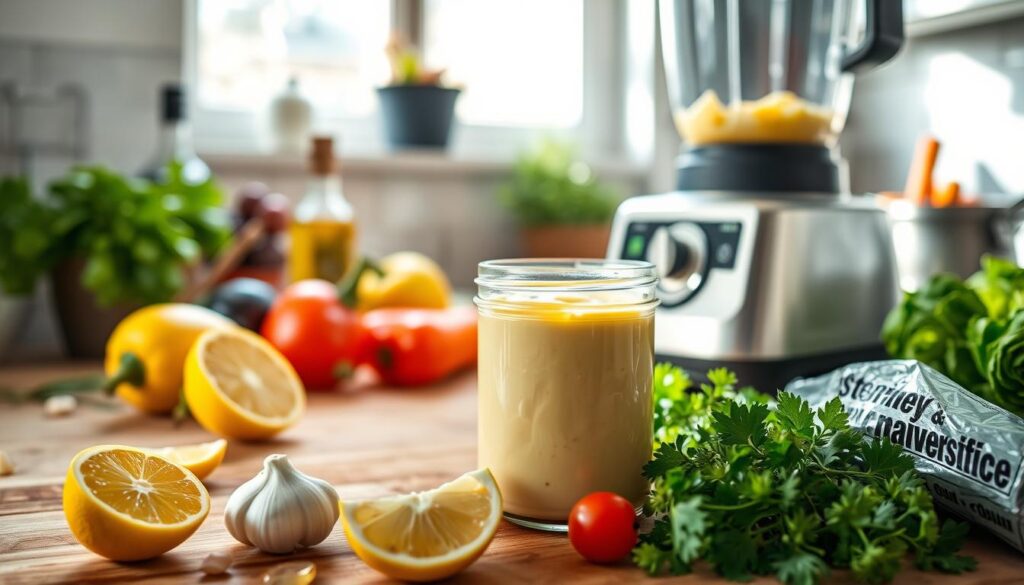
Vegan Mayonnaise Recipe: Ingredients Overview
Making vegan mayonnaise at home saves money and lets you tailor flavors. You’ll need unsweetened soy milk, apple cider vinegar, Dijon mustard, and oils. In about five minutes, you can make a creamy vegan mayo that makes your dishes better.
Key Ingredients in Vegan Mayo
The basic ingredients for easy vegan mayo are:
- Unsweetened soy milk or aquafaba as the base
- Sunflower oil or other neutral oils for creaminess
- Dijon mustard for tanginess
- Apple cider vinegar to enhance flavor
- Salt for seasoning
- Optional flavorings like garlic powder or lemon juice
These ingredients help create the mayo’s texture and taste. You can also add your favorite herbs or spices for a personal touch.
Choosing the Right Oil for Your Mayo
The type of oil you choose is key for the mayo’s consistency and flavor. Sunflower oil is a good choice because it has a light flavor and smooth texture. Avocado or canola oil can also work well.
But, avoid oils with strong flavors like olive oil. They can make the mayo taste too much. Using high-quality oils will make your mayo better. You can also try different oils to change the flavor and use it in many dishes.
For more exciting vegan recipes, check out these delicious gluten-free English muffins.
How to Make Your Vegan Mayonnaise
Making vegan mayonnaise at home is quick and easy. It takes less than 5 minutes. This recipe makes a creamy, tangy sauce that can make any dish better. You’ll need 1 cup of neutral oil, 1/2 cup of plant-based milk, 1 tablespoon of lemon juice, 1 tablespoon of white wine vinegar, and 1/2 teaspoon of salt.
Start by mixing the plant-based milk and oil in your blender. An immersion blender is best, but a food processor works too. Blend on high for 30 seconds to 1 minute until it starts to mix well. Next, add the lemon juice, vinegar, mustard, and salt. Keep blending until it’s smooth.

Your vegan mayonnaise will get thicker after it cools in the fridge. It’s great for spreading. For more flavor, try adding lactic acid or adjusting the salt. Keep it in a mason jar or airtight container for up to 2 weeks.
Try using different oils like canola, avocado, or sunflower for unique tastes. This easy vegan mayonnaise recipe is a tasty, dairy-free option for many dishes. It’s perfect for those who follow a plant-based diet.
Using an Immersion Blender versus Food Processor
Choosing between an immersion blender and a food processor can change your vegan mayonnaise-making experience. Both tools can make delicious vegan mayo quickly. Knowing the differences helps you pick the right one for your kitchen.
Benefits of Using an Immersion Blender
An immersion blender has many benefits for vegan mayonnaise. Its small size makes it easy to use in a jar, saving on cleanup. Here are some key tips for using an immersion blender:
- Fast processing time, typically under one minute.
- Minimal equipment to clean, as you only need the blender and the mixing container.
- Reliable results, as previous users have noted its effectiveness in creating creamy mayo.
- Room temperature ingredients enhance emulsification, ensuring a smoother texture.
Food Processor Tips for Perfect Emulsification
The food processor may need more cleaning, but it’s key for emulsification. Here are some tips for using a food processor to make mayo:
- Start with room temperature ingredients to maximize emulsification potential.
- Gradually add oil in a thin stream while the processor runs to ensure proper consistency.
- Incorporate natural emulsifiers, such as mustard and vinegar, to stabilize the mixture.
- If your mayo appears broken, don’t panic—add a few teaspoons of water or lemon juice and blend again for a creamy finish.
Both methods use the same ingredients, making your mayo-making journey versatile. The emulsification process is key for a creamy texture. Both options are reliable for this important step.
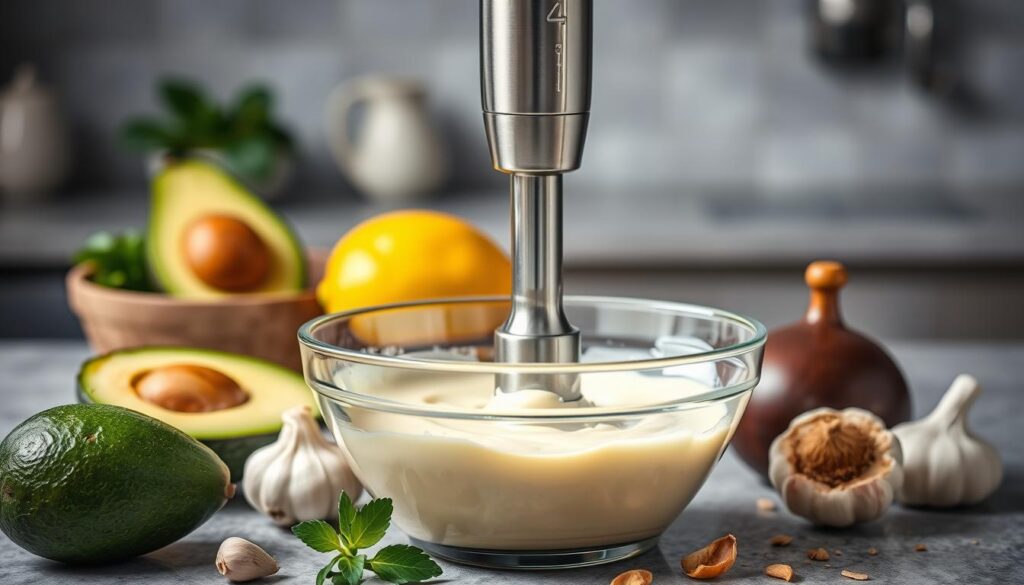
Storage Tips for Homemade Vegan Mayo
To keep your homemade vegan mayonnaise fresh, proper homemade mayo storage is key. Store it in an airtight container for up to two weeks in the fridge. This way, you can enjoy it without losing its taste and texture.
Over time, some liquid might separate from the mayo. Just stir it well to mix everything back together. If it’s too thin, adding a bit more oil can fix it. For a thicker mayo, chilling it will help it thicken more.
Using neutral-flavored oils like extra virgin olive oil or organic canola oil is best. They add flavor without making the mayo too heavy. For a detailed guide on making this healthy mayo, check out this homemade vegan mayo recipe.
Creative Ways to Use Vegan Mayonnaise
Homemade vegan mayonnaise is a game-changer in the kitchen. It’s not just for sandwiches anymore. It can make everyday meals taste amazing and fit your diet.
Add Flavor to Salads and Dishes
Vegan mayonnaise is great for boosting salad and dish flavors. It adds a creamy touch to salads. Try it in coleslaw or potato salad for a new taste.
It’s also perfect for homemade Caesar or ranch dressings. This way, you get a tasty meal without the cholesterol.
Making Dipping Sauces with Vegan Mayo
Make your snacks better with vegan mayonnaise in dipping sauces. Mix it with spices or herbs for tasty sauces. For example, spicy sriracha mayo is great with veggies or chips.
Discover more vegan condiment recipes that feature vegan mayonnaise. It’s a versatile ingredient for many delicious dips.
Vegan Mayonnaise Substitutes and Variations
Creating vegan mayonnaise is a fun journey. You can find vegan mayo substitutes for allergies or special tastes. Aquafaba, from canned chickpeas, is great for creaminess and mixing.
Looking for plant-based mayo variations? Try using different oils. Olive oil adds a deep flavor, while avocado oil is milder. Add spices like garlic powder or chipotle for more taste. A little kala namak gives it an eggy flavor.
Vegan mayonnaise is very flexible. You can make it thicker with silken tofu or hummus. Adding pesto gives it a herby taste and extra nutrients like Vitamin K.
Don’t be afraid to try new things. Whether it’s for a sandwich or a dipping sauce, tweaking the recipe can make a big difference. Check out this gluten-free bagels recipe that goes well with your vegan mayonnaise.
Conclusion
Making homemade vegan mayonnaise is easy and rewarding. You only need a few things like aquafaba, sea salt, and oil. In under 15 minutes, you can make a tasty vegan mayo.
This mayo is great for those who can’t eat eggs. It’s also safe because it doesn’t have raw eggs. Plus, it’s healthier than many store-bought options.
Homemade vegan mayo is not just healthy; it’s also super versatile. You can use it as a dressing, spread, or base for sauces. It makes any plant-based meal better.
While store-bought brands like Vegenaise are popular, homemade mayo is unbeatable. It has a fresh taste and you can make it just how you like it.
So, why not make your own vegan mayo today? With the right ingredients and a bit of practice, you’ll have a delicious, healthy mayo. Your meals will be better, and you’ll see how easy it is to make.
F.A.Q
What is vegan mayonnaise made from?
Vegan mayonnaise is made from soy milk or aquafaba, vegetable oils, Dijon mustard, and vinegar. You can also add garlic and lemon for extra taste. It’s creamy and has no dairy or eggs.
How do I store homemade vegan mayonnaise?
Keep your vegan mayonnaise in an airtight container in the fridge. It stays fresh for about two weeks. If it separates, just stir it back together.
Can I customize the flavor of my vegan mayonnaise?
Yes, you can! Add spices, herbs, or flavored oils to your vegan mayo. Try garlic, sriracha, or lemon juice for different tastes.
Why should I make my own vegan mayonnaise instead of buying it?
Making your own vegan mayo lets you control the ingredients. It’s healthier, customizable, and cheaper than store-bought. It’s a great choice for a tasty vegan condiment.
Can I use an immersion blender to make vegan mayonnaise?
Yes, an immersion blender is a good choice. It’s easy to clean and works well. Just make sure your ingredients are at room temperature.
What oils are best for making vegan mayonnaise?
Use light olive oil or sunflower oil for vegan mayo. They have a neutral taste. Avoid oils with strong flavors to keep the mayo tasting right.
Are there any substitutes for soy milk in vegan mayonnaise?
Yes, you can use aquafaba or other non-dairy milks as substitutes. They change the texture and taste a bit. Feel free to try different ones!
How can I use vegan mayonnaise in my recipes?
Vegan mayonnaise is great for dressings, salad spreads, and dips. It’s also good as a sandwich spread or on veggie burgers. It adds flavor to any dish.

